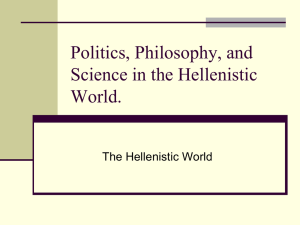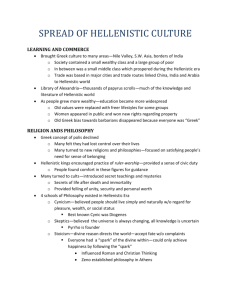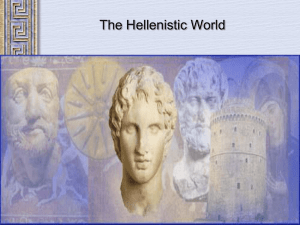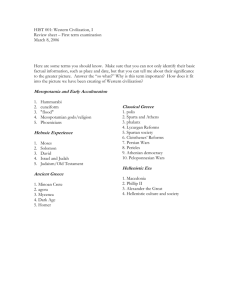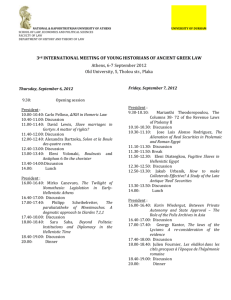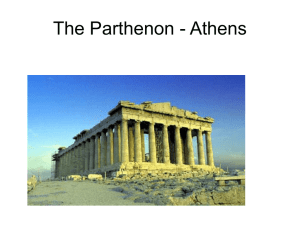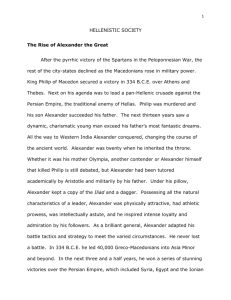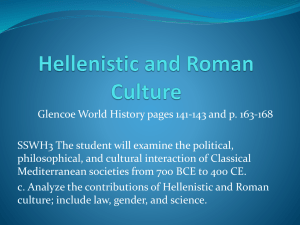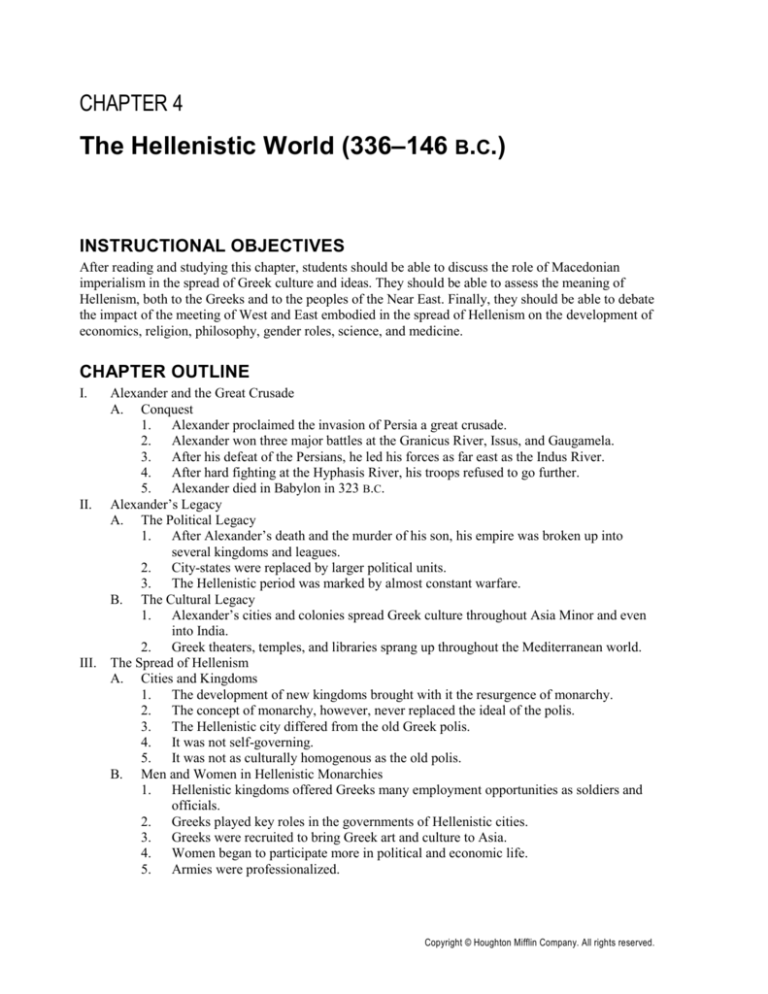
CHAPTER 4
The Hellenistic World (336–146 B.C.)
INSTRUCTIONAL OBJECTIVES
After reading and studying this chapter, students should be able to discuss the role of Macedonian
imperialism in the spread of Greek culture and ideas. They should be able to assess the meaning of
Hellenism, both to the Greeks and to the peoples of the Near East. Finally, they should be able to debate
the impact of the meeting of West and East embodied in the spread of Hellenism on the development of
economics, religion, philosophy, gender roles, science, and medicine.
CHAPTER OUTLINE
I.
Alexander and the Great Crusade
A. Conquest
1. Alexander proclaimed the invasion of Persia a great crusade.
2. Alexander won three major battles at the Granicus River, Issus, and Gaugamela.
3. After his defeat of the Persians, he led his forces as far east as the Indus River.
4. After hard fighting at the Hyphasis River, his troops refused to go further.
5. Alexander died in Babylon in 323 B.C.
II. Alexander’s Legacy
A. The Political Legacy
1. After Alexander’s death and the murder of his son, his empire was broken up into
several kingdoms and leagues.
2. City-states were replaced by larger political units.
3. The Hellenistic period was marked by almost constant warfare.
B. The Cultural Legacy
1. Alexander’s cities and colonies spread Greek culture throughout Asia Minor and even
into India.
2. Greek theaters, temples, and libraries sprang up throughout the Mediterranean world.
III. The Spread of Hellenism
A. Cities and Kingdoms
1. The development of new kingdoms brought with it the resurgence of monarchy.
2. The concept of monarchy, however, never replaced the ideal of the polis.
3. The Hellenistic city differed from the old Greek polis.
4. It was not self-governing.
5. It was not as culturally homogenous as the old polis.
B. Men and Women in Hellenistic Monarchies
1. Hellenistic kingdoms offered Greeks many employment opportunities as soldiers and
officials.
2. Greeks played key roles in the governments of Hellenistic cities.
3. Greeks were recruited to bring Greek art and culture to Asia.
4. Women began to participate more in political and economic life.
5. Armies were professionalized.
Copyright © Houghton Mifflin Company. All rights reserved.
Chapter 4: The Hellenistic World (336–146 B.C.)
C.
23
Greeks and Easterners
1. Greek culture spread among Eastern elites, but not the masses.
2. The vast majority of Hellenized Easterners took only the externals of Greek culture,
while retaining essential aspects of their own ways of life.
D. Hellenism and the Jews
1. The relationship between Greeks and Jews illustrates this trend.
2. Hellenism and Judaism usually met on friendly terms.
3. Few Jews became citizens, preferring to follow their own religion rather than worship
the gods of the city.
IV. The Economic Scope of the Hellenistic World
A. Commerce
1. The East was brought into the Greek sphere of economics.
2. Alexander’s conquests developed trade routes with India and Italy.
3. The Greeks sent their oil, wine, and fish to the north shore of the Black Sea in return
for grain.
4. The slave trade flourished.
B. Industry
1. Hellenistic agriculture and industry underwent significant changes.
2. There were few industrial innovations in the Hellenistic Age.
a) The inventions of mathematicians and other thinkers failed to produce
corresponding technological innovations.
b) Cheap labor left little motivation for innovation.
C. Agriculture
1. Hellenistic kings paid special attention to agriculture.
a) Much of their revenue was derived from the produce of royal lands.
b) Some kings sought out and supported agricultural experts.
V. Hellenistic Intellectual Advances
A. Religion in the Hellenistic World
1. Greek cults and Near Eastern religions did not mix much.
2. The only significant syncretisms were the “mystery religions” that spread rapidly.
3. The new mystery religions were not tied to a particular location.
4. The mystery religions promised protection from misfortune and the survival of the soul
after death.
5. The Egyptian cults of Serapis and Isis were among the most popular.
6. Many people resorted to magic to deal with everyday problems.
B. Philosophy and the People
1. Two schools of philosophy gained wide popularity in the Hellenistic world.
a) Epicureanism endorsed moderation, self-discipline, and a quietistic life.
b) Stoicism endorsed civic virtue, devotion to duty, and acceptance of one’s lot in
life.
C. Hellenistic Science
1. The Hellenistic period saw many advances in science.
2. Aristarchus of Samos propounded the heliocentric theory.
3. Euclid created a system of geometry still in use today.
4. Archimedes was the greatest thinker of the Hellenistic period.
5. Eratosthenes had wide ranging interests and made contributions in a number of areas.
6. The Greeks and Macedonians applied theories of mechanics to build new military
technologies.
7. Siege engines added to the destructiveness of war.
Copyright © Houghton Mifflin Company. All rights reserved.
24
Chapter 4: The Hellenistic World (336–146 B.C.)
8.
D.
Aside from military applications, Hellenistic people seldom put scientific discoveries
to practical use.
Hellenistic Medicine
1. Medicine also made significant advances through the work of Herophilus and
Erasistratus.
2. The Empiric school emphasized the prescription of medicine and drugs.
3. Dogmatists invented new surgical instruments and dissected corpses.
4. Doctors of the Empiric school challenged the Dogmatic emphasis on anatomy and
physiology, focusing on drugs and medicines, including painkillers such as opium.
5. Much of Hellenistic medicine was quackery.
LECTURE SUGGESTIONS
1.
“Great People and How They Get That Way: Alexander the Great.” What special qualities did
Alexander possess that made him appear larger than life and superior to his fellow men? Are these
qualities ones that he shares with other “great men and women” of history? How does one become
great? Sources: A. B. Bosworth, Conquest and Empire: The Reign of Alexander the Great (1988)
and Alexander and the East: The Tragedy of Triumph (1996); J. R. Hamilton, Alexander the Great
(1973); U. Wilcken, Alexander the Great (English translation, 1967).
2.
“Alexander the Commander.” Examine Alexander’s style of command and the contrasting
practices of successful military commanders in different historical periods. Source: John Keegan,
The Mask of Command (London, 1987).
3.
“The Cults and Their Followers.” Why did the Greeks turn to Eastern mystery cults for spiritual
fulfillment in the Hellenistic period? What characteristics of the cults were most appealing to the
West? Sources: J. B. Bullen, The Sun is God (1989); Walter Burkert, Ancient Mystery Cults
(1987); R. E. Witt, Isis in the Graeco-Roman World (1971); S. K. Heyob, The Cult of Isis among
Women in the Graeco-Roman World (1975); W. Burkert, Ancient Mystery Cults (1987).
USING PRIMARY SOURCES
Have students read passages in W. Heckel and J. C. Yardley's Alexander the Great: Historical Sources
in Translation (2003) that describe Alexander’s tactics and strategy. Have students generalize about
Alexander’s tactics and strategy based on Arrian’s primary account in a class discussion and then in a
short paper.
CLASSROOM ACTIVITIES
I.
II.
Classroom Discussion Suggestions
A. How did life in Macedonia prepare Alexander for success in the cosmopolitan world of
Greece and Asia Minor?
B. Why has Alexander been remembered so vividly?
C. How did the role of women change from the Hellenic period to the Hellenistic period?
D. What scientific innovations were made during the Hellenistic period?
Doing History
A. Give students an outline map of the eastern Mediterranean region that also includes Asia
Minor and India. Have them plot the route of Alexander’s conquests. Discuss with them the
importance of certain ancient cities such as Babylon and Alexandria. Some attention might
be given to the importance of these cities in today’s world.
B. Alexander the Great is a lasting example of how a great person can influence historical
developments. Do great people make history or does history make great people? Have
Copyright © Houghton Mifflin Company. All rights reserved.
Chapter 4: The Hellenistic World (336–146 B.C.)
25
students research and write short papers about the hero approach to history. Sources: S.
Hook, The Hero in History (1943); W. W. Tarn, Alexander the Great (1956).
C. Have students look at art books that include pictures of wall paintings and sculpture from the
Hellenistic period. Have them comment on whether they feel the art in any way reflects the
changes that occurred in the Hellenistic world. Source: H. Gardner, Art through the Ages
(many editions).
III. Cooperative Learning Activities
A. Organize the class into teams of six. Assign them the task of learning about the battles of
Alexander the Great (this is a follow-up to the primary source activity described above).
Each group becomes expert on a particular Alexandrian battle: Chaeronea, Gaugamela,
Issus, the Hydaspes, and so on. Each team should present an overview of the battle, listing
troop placements on the chalkboard, overhead, or handout.
B. Dramatizing Philosophy
Divide the class into two groups. Each group is assigned the task of writing a short one-act
play illustrating the philosophy of Epicureanism or Stoicism. The play might be set in the
Hellenistic Era or in modern times. Each group might discover and elect a director,
scriptwriter(s), scenery maker, actors, and so on. The students, ultimately, should present
their plays in class.
MAP ACTIVITY
1.
Using an outline map of the world, have students do brief research reports on a select number of
world locations for the era of Alexander the Great. What was going on in each of these areas?
Have students list these places on a large wall map of the world and tell the class what was
happening when Alexander died.
2.
Using Map 4.2 (The Hellenistic World) as a reference, answer the following questions.
a.
Why did kingdoms and leagues dominate the political landscape of the Hellenistic world?
b.
What role did cities play in the cultural and economic life of the Hellenistic world? How did
their role differ from that of the old Greek city-states?
c.
What role did geography play in facilitating the diffusion of Greek culture, language, and
ideas?
AUDIOVISUAL BIBLIOGRAPHY
1.
Greek and Roman Legends. (35 min. Color. Films for the Humanities and Sciences.)
2.
Alexander the Great. (135 min. Color. Films, Inc.)
3.
Games and Festivals. (27 min. Color. Media Guild Films.)
4.
Coins of the World: History in Metal. (18 min. Color. Centron Corporation.)
5.
The Jason Voyage: The Quest for the Golden Fleece. (Videodisc. Films for the Humanities and
Sciences.)
6.
Time Table of History. (CD-ROM. National Audio-Visual Supply.)
7.
Alexander the Great: Pictures (www.livius.org/ajal/alexander/alexander_pic/alexander_pics.html)
8.
J. Paul Getty Museum (www.getty.edu/museum)
Copyright © Houghton Mifflin Company. All rights reserved.
26
9.
Chapter 4: The Hellenistic World (336–146 B.C.)
Map: The Hellenistic World: Cities and Empires in 240 B.C.
(darkwing.uoregon.edu/~atlas/europe/static/map09.html)
10. Map: The Hellenistic World: Major and Minor States in 90 B.C.
(darkwing.uoregon.edu/~atlas/europe/static/map10.html)
11. Map: Macedonian Expansion Under Philip and Alexander
(darkwing.uoregon.edu/~atlas/europe/interactive/map23.html)
INTERNET RESOURCES
1.
Hellenistic Greece (www.wsu.edu:8080/~dee/GREECE/HELLGREE.HTM)
2.
Ancient Greece: The Hellenistic Age (www.art-andarchaeology.com/timelines/greece/hellenistic/hellenistic.html)
3.
Hellenistic Greek Culture (www.fordham.edu/halsall/hellenistic)
4.
Alexander the Great On the Web (www.isidore-of-seville.com/Alexanderama.html)
5.
Ancient Europe: Alexander the Great (history.boisestate.edu/westciv/alexander)
SUGGESTED READING
General treatments of Hellenistic political, social, and economic history can be found in F. W. Walbank
et al, The Cambridge Ancient History, 2d ed., vol. 7, pt. 1 (1984). Shorter is F. W. Walbank, The
Hellenistic World, rev. ed. (1993), a fresh appraisal by one of the foremost scholars in the field. The
undisputed classic in this area is M. Rostovzeff, The Social and Economic History of the Hellenistic
World, 3 vols. (1941). More recently Z. H. Archibald et al., Hellenistic Economics (2001), has reopened
the topic with fresh results. R. M. Errington, A History of Macedonia (English trans., 1990), places
Macedonian clearly within a much broader Hellenistic context. A new examination of significant
aspects of the period comes form R. W. Wallace and E. M. Harris, eds., Transitions to Empire, pt. 2
(1996). Good selections of primary sources can be found in M. M. Austin, The Hellenistic World from
Alexander to the Roman Conquest (1981), and S. M. Burstein, The Hellenistic Age from the Battle of
Ipsos to the Death of Kleopatra III (1985).
Each year brings a new crop of biographies of Alexander the Great. Still the best is J. R. Hamilton,
Alexander the Great (1973). D.J. Lonsdale, Alexander the Great (2007), gives special treatment to
Alexander’s generalship. E. Badian, Collected Papers on Alexander the Great (2006), covers a wide
range of topics. G. Shipley, The Greek World After Alexander (1999), treats the entire period between
323 and 30 B.C.
Political studies of the Hellenistic period include A. B. Bosworth, Conquest and Empire (1988), which
sets Alexander’s career in a broad context, and F. L. Holt, Alexander the Great and Bactria (1988),
which discusses the formation of a Greco-Macedonian frontier in central Asia. Several works deal with
the Hellenization of much of the Mediterranean world: P. M. Frazer, Cities of Alexander the Great
(1996), a welcome contribution to the understanding of the impact of the Greeks on the world around
them. Among the studies of those who shaped these developments, J. J. Gabbert, Antigonus II Gonatas
(1997), treats one of the most influential of Alexander’s successors. J. Ma, Antiochus III and the Cities
of Western Asia Minor (2000), makes an important contribution to the spread and significance of
Hellenism throughout this rich area.
A. K. Bowman, Egypt After the Pharaohs (1986), is a readable account of the impact of the Greeks and
Macedonians on Egyptian society. The same topic is treated by N. Lewis, a major scholar in the field,
in his Greeks in Ptolemaic Egypt (1986). A brief study comes from the pen of another major scholar, A.
E. Samuel, The Shifting Sands of History: Interpretations of Ptolemaic Egypt (1989), which deals with
Copyright © Houghton Mifflin Company. All rights reserved.
Chapter 4: The Hellenistic World (336–146 B.C.)
27
history and historiography. W. Heckel, The Marshal’s of Alexander’s Empire (1992), treats the careers
of more than 130 men who were not actually Alexander’s chief officers but nonetheless substantially
shaped Hellenistic political history. S. Sherwin-White and A. Kuhrt, From Samarakand to Sardis
(1992), offer a study of the Seleucid monarchy that puts it in an Asian rather than a Greek perspective.
J. D. Grainger, Seleukos Nikator (1990), examines how the Hellenistic king created his empire. R. A.
Billows, Antigone the One-Eyed and the Creation of the Hellenistic State (1990), examines the career
of the one man who most nearly reunited Alexander’s empire. E. V. Hansen, The Attalids of Pergamon,
2d ed. (1971), though dated, is still the best treatment of the kingdom. B. Bar-Kochva, Judas
Maccabaeus (1988), treats the Jewish struggle against the Seleucids and Hellenistic influences.
Much work has focused on the spread of Hellenism throughout the Near Neat. Very extensive is A.
Kuhrt and S. Sherwin-White, eds., Hellenism in the East (1988), which touches on a broad range of
topics, including biblical studies, Christianity, and Islam. A. E. Samuel, The Promise of the West
(1988), studies the connections among Greek, Roman, and Jewish culture and thought and their
significance for Western history. P. McKechnie, Outsiders in the Greek Cities of the Fourth Century
(1989), provides an interesting study of the social dislocation of the Greeks in the time of Philip II and
Alexander the Great. N. L. Collins, The Library in Alexandria and the Bible in Greek (2000),
demonstrates that King Ptolemy ordered the translation of the Bible into Greek to increase his famous
library and attract foreign scholars.
No specific treatment of women in the Hellenistic world yet exists, but studies shed light on certain
aspects of the topic. N. L. Goodrich, Priestesses (1989), examines the importance of priestesses in cults
from the Near East to Ireland. S. B. Pomeroy, Women in Hellenistic Egypt (1984), studies women in the
kingdom from which the most ancient evidence has survived. R.V. Bremen, The Limits of
Participation: Women and Civic Life in the Greek East in the Hellenistic and Roman Periods (1996)
looks at the issue of women’s citizenship.
Two general studies of religion in the Hellenistic world are F. Grant, Hellenistic Religion: The Age of
Syncretism (1953), and H. J. Rose, Religion in Greece and Rome (1959). L. H. Feldman, Jew and
Gentile in the Ancient World (1993), argues that the pagan response to Judaism within the GrecoRoman period was not as negative as often thought. R. van den Broek et al., eds., Knowledge of God in
the Graeco-Roman World (1988), is a difficult but rewarding collection of essays that points out how
similarly pagans, Hellenistic Jews, and Christians thought about human attempts to know God. R. E.
Witt, Isis in the Graeco-Roman World (1971), an illustrated volume, studies the origins and growth of
the Isis cult. More specifically, S. K. Heyob, The Cult of Isis Among Women in the Graeco-Roman
World (1975), explores its popularity among women. The cult of Isis’s consort Osiris is the subject of J.
G. Griffiths, The Origins of Osiris and His Cult (1980). For the mystery cults in general, see W.
Burkert, Ancient Mystery Cults (1987), written by one of the finest scholars in the field.
Hellenistic philosophy and science have attracted the attention of a number of scholars, and the various
philosophical schools are especially well covered. A general treatment can be recommended because it
deals with the broader question of the role of the intellectual in the classical Hellenistic worlds: F. L.
Vatai, Intellectuals in Politics in the Greek World from Early Times to the Hellenistic Age (1984).
Broader is S. Blundell, The Origin of Civilization in Greek and Roman Thought (1986), a survey of
classical political and social theories through a period of ten centuries, from Aristotle to the Stoics and
their Roman successors. A. W. Bulloch et al., Images and Ideologies (1993), is a broad-ranging work
that studies all the important intellectual aspects of Hellenistic history. Newer and also comprehensive
is R. W. Sharples, Stoics, Epicureans, Skeptics (1996), which provides a good synthesis of these three
major branches of Hellenistic philosophy. A good survey of Hellenistic science is G. E. R. Lloyd,
Greek Science After Aristotle (1963), and specific studies of major figures can be found in T. L. Heath’s
solid work, Aristarchos of Samos (1920), still unsurpassed, and E. J. Dijksterhuis, Archimedes, rev. ed.
(1987).
Copyright © Houghton Mifflin Company. All rights reserved.

